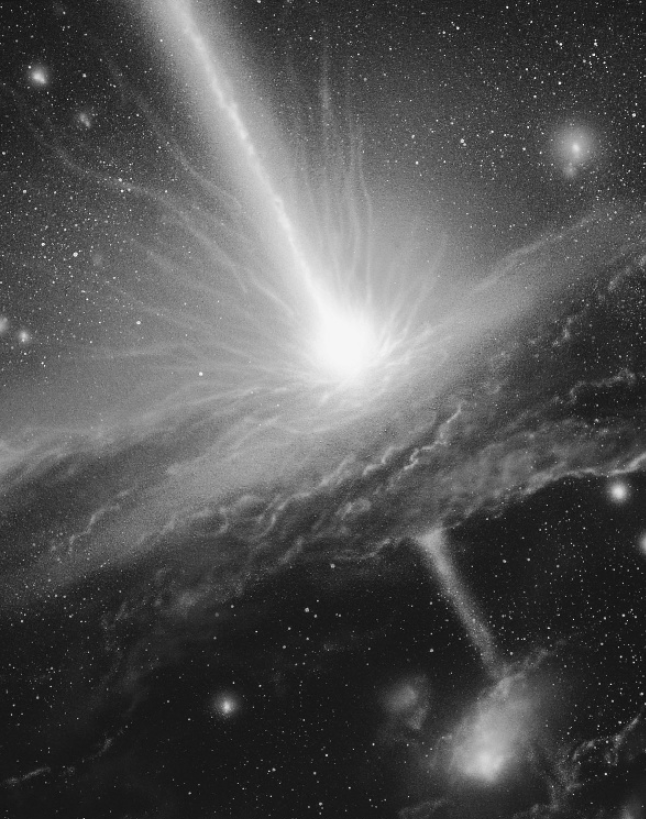


 الفيزياء الكلاسيكية
الفيزياء الكلاسيكية
 الكهربائية والمغناطيسية
الكهربائية والمغناطيسية
 علم البصريات
علم البصريات
 الفيزياء الحديثة
الفيزياء الحديثة
 النظرية النسبية
النظرية النسبية
 الفيزياء النووية
الفيزياء النووية
 فيزياء الحالة الصلبة
فيزياء الحالة الصلبة
 الليزر
الليزر
 علم الفلك
علم الفلك
 المجموعة الشمسية
المجموعة الشمسية
 الطاقة البديلة
الطاقة البديلة
 الفيزياء والعلوم الأخرى
الفيزياء والعلوم الأخرى
 مواضيع عامة في الفيزياء
مواضيع عامة في الفيزياء|
Read More
Date: 23-12-2015
Date: 24-12-2015
Date: 26-1-2017
|
Time Tunnels and Primordial Bubbles
If exotic matter does exist naturally or else can be manufactured, the problem of keeping a wormhole open and stable would be solved. And barring any other unforeseen impediments, it would be possible to travel through such a cosmic tunnel. But why would someone embark on such a journey? Assuming they manage to develop the advanced technology required to stabilize and manipulate wormholes, why would humans or other intelligent beings choose travel in hyperspace over travel in ordinary space?
First, the math suggests that wormholes might create shortcuts to distant locations. In other words, if it takes a thousand years for a fast-moving spaceship to reach a faraway planetary system, manipulating a wormhole in just the right manner might allow the ship to make the trip in a much shorter amount of time. Scientists often point to the analogy of a watermelon, the outer surface of which represents normal space. An ant walking on the watermelon represents a spacecraft on a long journey to a distant location on the opposite side of the watermelon. Even when moving as fast as it can, the ant requires three full minutes to complete the trip. Just before setting out, however, the creature sees a nearby hole, the mouth of a tunnel that appears to go straight into the heart of the watermelon. The ant thinks twice about entering the hole because it seems to lead into an unknown region very different from the familiar realm of the surface. But it takes a chance and crawls down the hole. Following the tunnel, the ant travels straight through the center of the watermelon and climbs out of another hole on the opposite side, right beside its destination. The route it chose is shorter and more direct than the one on the surface, so the trip took only a minute instead of three.
In a similar manner, people in spaceships might someday take advantage of wormholes to reach faraway locations faster. If so, they will also travel through time. Just as time slows down for objects and people traveling near the speed of light in normal space, time will behave strangely and changeably inside a black hole or in hyperspace. To an astronaut floating inside a black hole (if it is actually possible to do so), time would seem to pass quite normally. But from his or her point of view, the universe outside the event horizon would appear to move abnormally fast. The astronaut might remain in hyperspace for a week and then exit the wormhole to find that the world he or she left had aged ten thousand years.
Another possibility is that some wormholes might lead not to other parts of the known universe, but instead to unseen alternate universes. No direct evidence for such places has yet been found. But some scientists have suggested that the violent explosion

An artist captures a dramatic vision of the M87 galaxy, with immense jets produced by a central black hole of 5 billion solar masses.
of the Big Bang could conceivably have created “bubbles,” shells encasing distorted regions of space and time separate from and completely invisible to ordinary space and time. There is no guarantee that the known laws of physics would be the same inside these bubble universes. So any humans who entered such a place via a wormhole might die instantly, or at least find themselves in an unimaginably bizarre and hostile environment.
Invoking the image of the Big Bang suggests one final, mind-bending concept involving black holes. As near as scientists can tell, that tremendous primeval explosion expanded outward from a single, infinitely small point in spacetime, a point exactly like the theoretical singularity of a black hole. Perhaps the known universe emerged from a massive superdense object. And the atoms making up our bodies, Earth, the stars, and everything else we can see coalesced from the compact, swirling energies buried deep inside the guts of the greatest of all cosmic monsters. As Begelman and Rees put it:
Hidden from view inside their “horizons,” [black holes] hold secrets that transcend the physics we understand. The central “singularity” involves the same physics that occurred at the initial instants of the Big Bang and will recur again if the universe recollapses. When we really understand black holes, we will understand the origin of the universe itself.



|
|
|
|
علامات بسيطة في جسدك قد تنذر بمرض "قاتل"
|
|
|
|
|
|
|
أول صور ثلاثية الأبعاد للغدة الزعترية البشرية
|
|
|
|
|
|
|
مكتبة أمّ البنين النسويّة تصدر العدد 212 من مجلّة رياض الزهراء (عليها السلام)
|
|
|